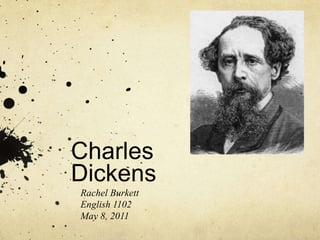
Charles dickens presentation
- 1. Charles Dickens Rachel Burkett English 1102 May 8, 2011
- 2. Agenda Introduction Works Overview Oliver Twist David Copperfield A Tale of Two Cities Great Expectations Works Cited
- 3. Introduction Charles John Huffam Dickens, born February 7, 1812 in Portsmouth, Hampshire, to John and Elizabeth Dickens. He was sent to work in the Warren’s Blacking Factory at the age of twelve after his father was arrested for debt. He worked 10 hour days in absolutely atrocious working conditions applying labels to shoe polish. His horrific experience during this time, although only a few months, forever changed his views, and set the precedence for his writing style.
- 4. Introduction Continued Charles Dickens used his experiences at the factory to produce some of the most well known works of all time. He is depicted as the greatest English novelist, and is considered second only to Shakespeare among all English writers. Throughout his works Dickens political and socialist views are very relevant. He writes of the life of individuals, often children, who are poor and mistreated by someone of authority or wealth. However, these individuals go on to live a much happier existence, while the individuals who hurt them typically meet a less appealing fate.
- 5. Introduction Continued Dickens strongly supported the class system, and used the writing of this story Oliver Twist, to back his argument on socialist policies. Dickens used the profits from this book to create a foundation called Britains for Socialism Foundation. Dickens gave a series of “farewell readings” close to the end of his life, in London, during 1870. It is said that at the end of his last reading he spoke the words, “From these garish lights I vanish now forevermore.” It is said, according to Dickens obituary, that his very last words were, “Be natural my children. For the writer that is natural has fulfilled all of the rules of art.” Charles Dickens signature
- 6. Works Overview Oliver Twist (1838) David Copperfield (1850) A Tale of Two Cities (1859) Great Expectations (1860) While Charles Dickens has numerous works I chose to narrow my focus to a few that provide a true and vivid depiction of how his views on politics and socialism were reflected in his writings. Also, these works provide an example of how Dickens’ characters often overcome a their vicious life, and go onto find happiness. While, in a favorable twist, the evil character's seem to meet a less fortunate fate.
- 7. Oliver Twist The second novel written by Charles Dickens. The story follows the young life of an orphan who endures a horrible life in a workhouse (a place where those unable to support themselves are offered employment and housing). Oliver is later placed with an undertaker of whom he later escapes, but only to fall into the evil hands of a pickpocket gang. This book is known for exposing the terrible treatment of orphaned children in London during this time.
- 8. David Copperfield This story follows the life of David Copperfield from childhood to adult. As a child David is sent to a boarding school by his stepfather because he defended himself during a beating. After the death of his mother and brother, his stepfather sends him to work in a factory. The story continues into David’s adult years, and so many traits of his character can be applied to Dickens’ himself. This novel is said to follow many events of Dickens own life, and out of all his works is known as the closest to an autobiography.
- 9. A Tale of Two Cities It takes place in the early years of the revolution, and provides a look into the demoralization of the peasants by the aristocrats, and in a twist the brutal treatment of former aristocrats by the revolutionaries. This novel is reviewed as one of the most famous works in history of fictional literature.
- 10. Great Expectations Written in first person, this story follows the life of an orphan named Philip Pirrip, nicknamed Pip. In the beginning Pip lives with is abusive sister and her husband, but he is later sent to live with a woman who teaches him to work as a laborer, despite his hopes she will teach him to be a gentleman. The story continues to follow Pip throughout his life through adulthood. He eventually inherits a fortune. The majority of critics agree that this novel is Dickens greatest.
- 11. Works Cited Merriman, C.D. The Literarture Network. Charles Dickens. (2006). Retrieved 01, May 2011. http://www.online-literature.com/dickens Wikipedia Foundation, Inc. Wikipedia,The Free Encyclopedia. Charles Dickens. (26, April 2011). Retrieved 01, May 2011. http://en.wikipedia.org/wiki/Charles_Dickens Wikipedia Foundation, Inc. Wikipedia, The Free Encyclopedia. Oliver Twist. (01, May 2011). Retrieved 01, May 2011. http://en.wikipedia.org/wiki/Oliver_Twist Wikipedia Foundation, Inc. Wikipedia, The Free Encyclopedia. David Copperfield. (30, April 2011). Retrieved 01, May 2011. http://en.wikipedia.org/wiki/David_Copperfield_(novel) Cody, David. The Victorian Web. Dickens, A Brief Biography. (2004). Retrieved 01, May 2011. http://www.victorianweb.org/authors/dickens/dickensbio1.html
- 12. Works Cited Continued Kalil, Marie. CliffsNotes. A Tale of Two Cities. (2011). Retrieved on 01, May 2011. http://www.cliffsnotes.com/study_guide/literature/A-Tale-of-Two-Cities-Charles-Dickens-Biography.id-126,pageNum-184.html Bailey, Debra A. CliffsNotes. Great Expectations. (2011). Retrieved 01, May 2011. http://www.cliffsnotes.com/study_guide/literature/Great-Expectations-About-Great-Expectations.id-118,pageNum-2.html Wikipedia Foundation, Inc. Wikipedia, The Free Encyclopedia. Great Expectations. (08, May 2011). Retrieved 08, May 2011. http://en.wikipedia.org/wiki/Great_Expectations Hromatko, Wesley. Unitarian Universalist Historical Society (UUHS). Charles Dickens. (2011). Retrieved 01, May 2011. http://www25.uua.org/uuhs/duub/articles/charlesdickens.html Charles Dickens Online, The Works and Life of Charles Dickens. Charles Dickens. (2011). 01, May 2011. http://www.dickens-online.info/